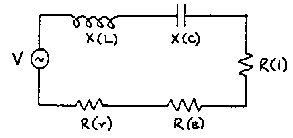MAGNETIC MOMENTS, Number 3
(originally printed in Speleonics 3, Fall, 1985)By Ian Drummond
This article deals with reception of the signal. The receiving antenna must absorb some power from the magnetic field set-up by the transmitting antenna. This signal is then amplified (as well as unwanted signals being rejected ) so that it can be detected, normally by listening with earphones.
The voltage induced in a loop of wire by a magnetic field is :
| where: f = | frequency (Hertz) |
| A = | area ( m2 ) |
| n = | # of turns of wire |
| H = | magnetic field ( A/m ) |
| q = | angle of the antenna to the magnetic field |
The power the antenna can deliver to the first stage amplifier depends upon the impedance of the antenna and the load. The equivalent circuit of the antenna and load for a directly coupled antenna is as follows.

| where: V = | the induced voltage as given above |
| X(L) = | inductive reactance of the circuit (antenna and first stage) |
| X(C) = | Capacitive reactance of the circuit |
| R(r) = | Radiation resistance of the loop |
| R(e) = | Equivalent AC resistance of the loop |
| R(l) = | Load resistance |
Then the power dissipated in the load is given by:
| P = | V2 R(l) | watts |
|
(R(r) + R(l) + R(e))2 + (X(C) + X(L))2 |
For practical low frequency loops, R(r) = 0
For tuned loops, X(C) = -X(L)
and, maximum power is transferred to the load when R(e) = R(l)
so, P (max) = V2 / 4 R(e) watts
Since R(e) = 2 p
f L / Q Ohms,
where Q = the unloaded antenna Q
Substituting for V gives,
P (max ) = 8. p 3 x 10-14 f H2 A2 n2 Q L-1 watts
For an antenna which is transformer coupled to the receiver, maximum power will be the same as in the directly coupled case, but the receiver input must match the transformed impedance of R(e). That is, the receiver input must equal R(e).(n(p)/n)2, where n(p) = the # of link turns to the antenna
Example
My transceiver uses the same design of antenna for both transmitting and receiving.
When transmitting, NIA = 11.3 A.m2
If the ground has a conductivity of 0.005 mhos/m, using the information in Magnetic Moments #1, at 100 m or approx. 5 skin-depths, H = 1.2 x 10-7 A/m
The maximum power which can be delivered to the receiver for
f = 115.4 kHzis 4 x 10-14 watts. (This is not going to keep you warm if you are lost in a cave ! )
n = 70
L = 11 mH
A = 0.51 m2
Q = 85
To obtain this power the receiver input impedance must be matched to the antenna, and be equal to R(e).(1/70)2 ohms, because of the one turn link transformer.
Input impedance = (2 p f L / Q) /702 ohms = 0.02 ohms
That is, this antenna acts as a current source and requires a very low impedance first stage, such as a common base amplifier.
Next time I will discuss the effects of atmospheric noise on the reception of the signal.
Return to the Top of the Page
Copyright © 2000 Communications & Electronics Section of the NSS, Inc. - All Rights Reserved.